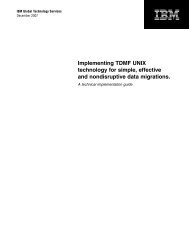A Primer for Healthcare Managers - IBM
A Primer for Healthcare Managers - IBM
A Primer for Healthcare Managers - IBM
Create successful ePaper yourself
Turn your PDF publications into a flip-book with our unique Google optimized e-Paper software.
wide range of service scenarios to map possible<br />
service needs. In addition, managers need to adopt<br />
a mechanism to monitor, anticipate, and address<br />
changing service needs. Failure to anticipate a<br />
possible change in service needs may result in a<br />
service-level contract that has very limited flexibility.<br />
To cope with change, a scalable IT service infrastructure<br />
is preferred, and a provision in the contract<br />
to address change is necessary.<br />
Mapping operational relationships<br />
After clarifying the sourcing needs, an outsourcing<br />
management team needs to develop a plan <strong>for</strong><br />
an operational relationship. The mapping of an<br />
operational relationship should keep its focus on<br />
partnership opportunities. The relationship should be<br />
consistent with the organization’s long-term strategic<br />
direction and proper allocation of human resources<br />
outlined in the first phase. This operational relationship<br />
needs to delineate the working relationships<br />
among different units involved in the delivery and use<br />
of IT services (GAO, November 2001).<br />
The composition of the management team should<br />
include key members of both the client organization<br />
and the vendor. At the client organization, an IT<br />
department and functional user groups are natural<br />
candidates. An IT department is able to bring<br />
in its knowledge of current IT operations and the<br />
technical components of the transition. User departments,<br />
such as a human resources department,<br />
can communicate their service needs to the vendors.<br />
Vendors are then responsible <strong>for</strong> the actual production<br />
and provision of IT services.<br />
In addition to determining the departments or units<br />
involved, a management team needs to decide the<br />
level of organization that is appropriate <strong>for</strong> the joint<br />
ef<strong>for</strong>t and the appropriate team members. If the IT<br />
services support the entire organization’s IT function<br />
and serve multiple departments, a high-level manager<br />
should be a member of the IT outsourcing team.<br />
The appropriate level of management is usually a<br />
function of the services outsourced.<br />
One key management task at this phase is to assess<br />
the resource requirements. An IT outsourcing project<br />
team needs to estimate the human and financial<br />
resource requirements <strong>for</strong> operational tasks. Taking<br />
a process-oriented and holistic view of IT outsourcing<br />
helps cover all potential resource requirements.<br />
<strong>Managers</strong> need to think about the resource needs<br />
beyond the first two phases of determining sourcing<br />
strategies and needs. They need to budget<br />
resources <strong>for</strong> all remaining phases of IT outsourcing.<br />
Building and maintaining an operational relationship<br />
involves intensive vendor selection, service agreement<br />
negotiation, transition, maintenance of ongoing<br />
IT service projects, and per<strong>for</strong>mance evaluation<br />
and service adjustment. Moreover, the management<br />
team at this phase should continue involving key<br />
stakeholders, particularly the user department and<br />
IT personnel.<br />
Phase 2: Best Practices<br />
• Cover multiple dimensions of sourcing needs.<br />
Security, business continuity, reliability, and<br />
service integration needs are the main ones.<br />
• Determine the level of service needs. A cost/<br />
benefit analysis is useful <strong>for</strong> assessing the<br />
proper level of service <strong>for</strong> each dimension.<br />
• Anticipate the change in service needs.<br />
<strong>Managers</strong> need to anticipate any possible<br />
change in service needs and usually prefer a<br />
scalable IT solution.<br />
• Build a team-based operational relationship<br />
that meets the sourcing needs. Resource<br />
requirements as well as operational<br />
relationships should be clearly stated and<br />
aligned with sourcing needs.<br />
The deliverables of this phase include a request <strong>for</strong><br />
proposals (RFP), an internal operational plan, and<br />
the <strong>for</strong>mation of an IT outsourcing project team to<br />
carry out tasks <strong>for</strong> the next phase. This proposal will<br />
have guidelines <strong>for</strong> the service requests developed<br />
in this phase and the criteria <strong>for</strong> appropriate vendors<br />
developed in the first phase. This detailed planning<br />
up front is necessary <strong>for</strong> an organization<br />
to harvest the fruits of a strategic partnership with a<br />
vendor. An internal operational plan will give a clear<br />
indication of the organizational resources involved<br />
and the composition of team members in order to<br />
build a relationship with potential vendors. The<br />
<strong>for</strong>mation of an IT outsourcing project team<br />
can then help oversee the vendor selection and<br />
subsequent intensive contract negotiations.<br />
<strong>IBM</strong> Center <strong>for</strong> <strong>Healthcare</strong> Management 15

















